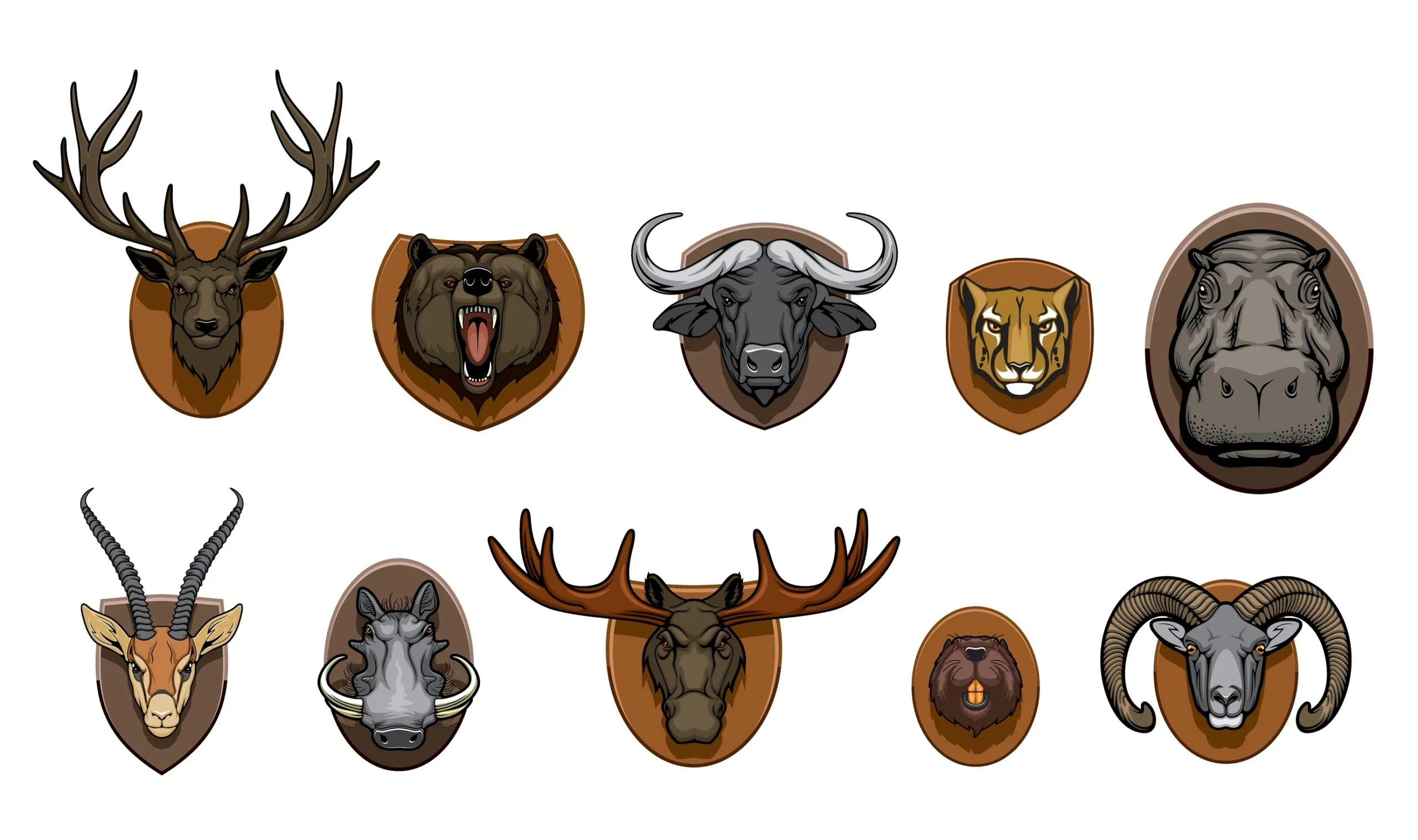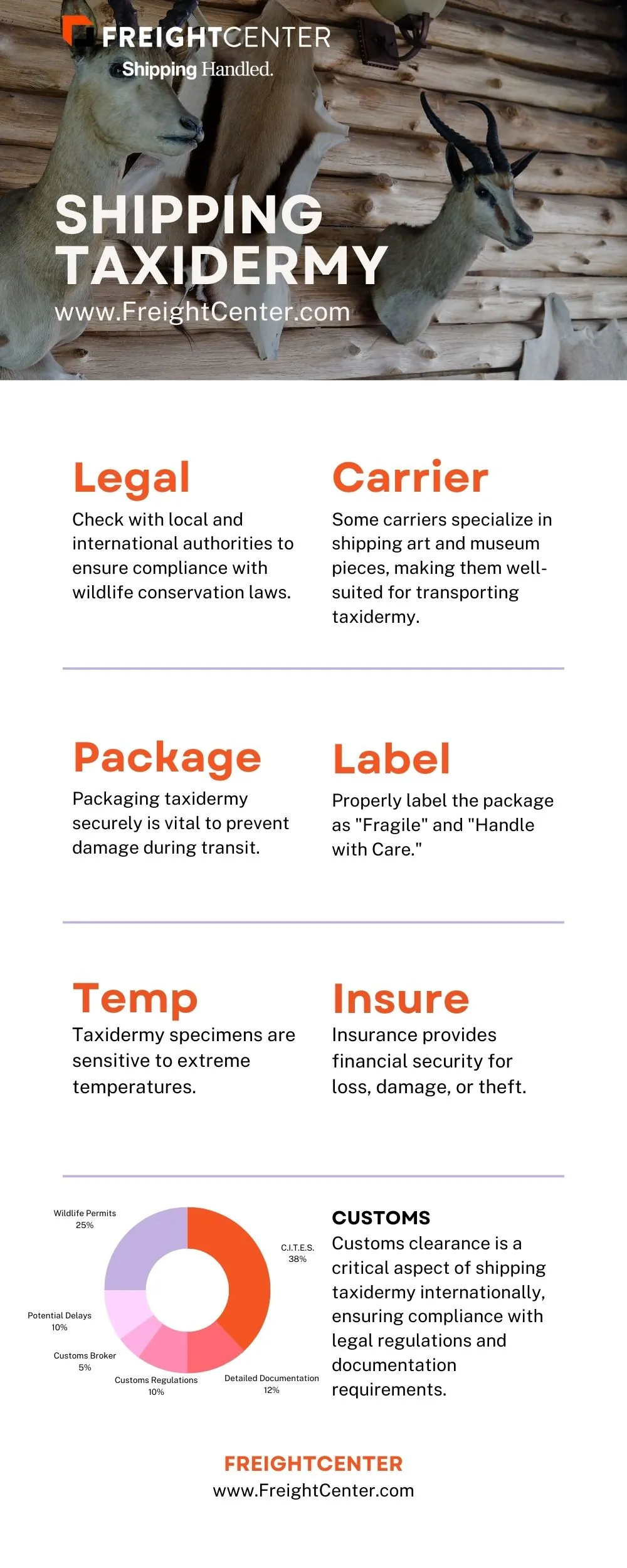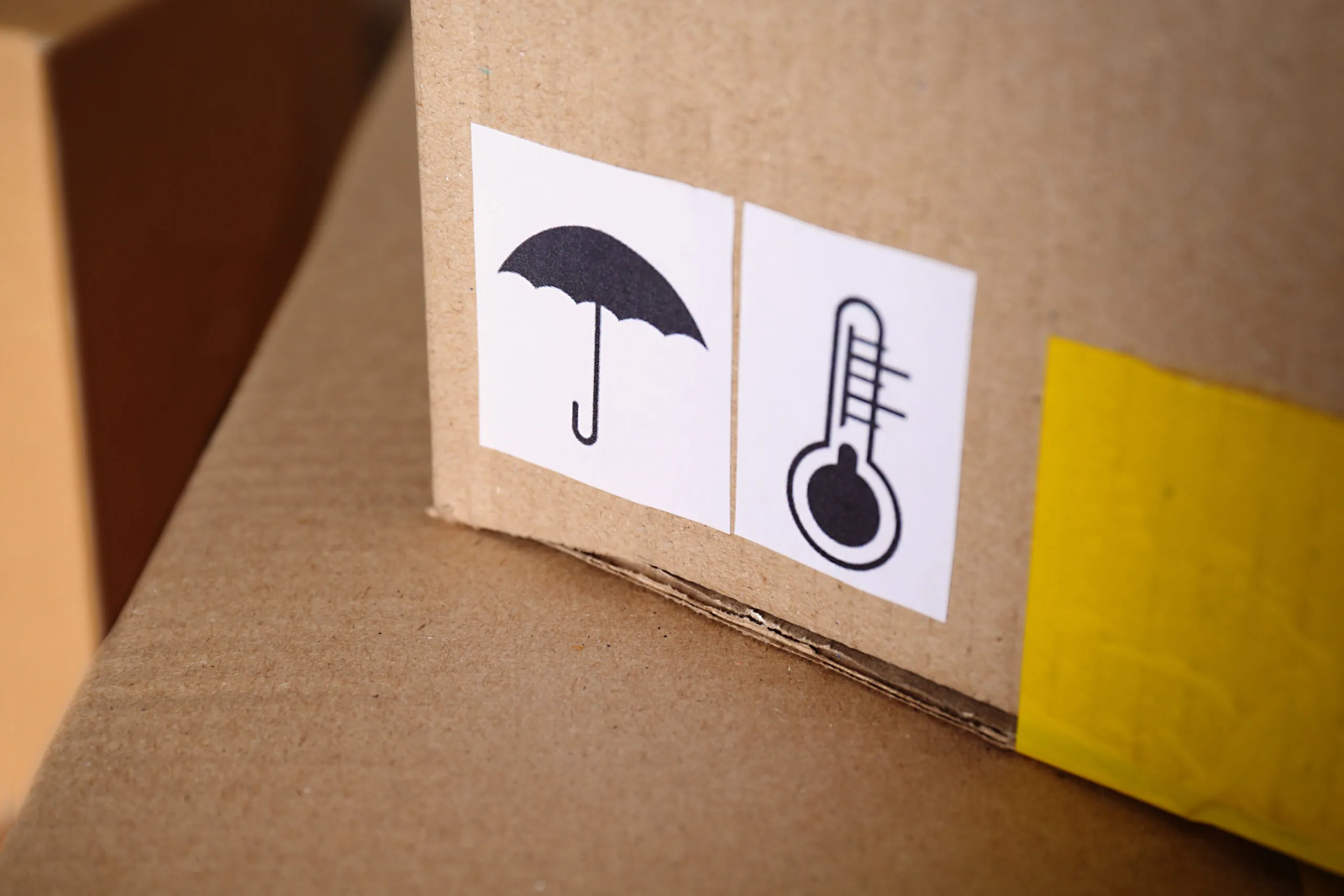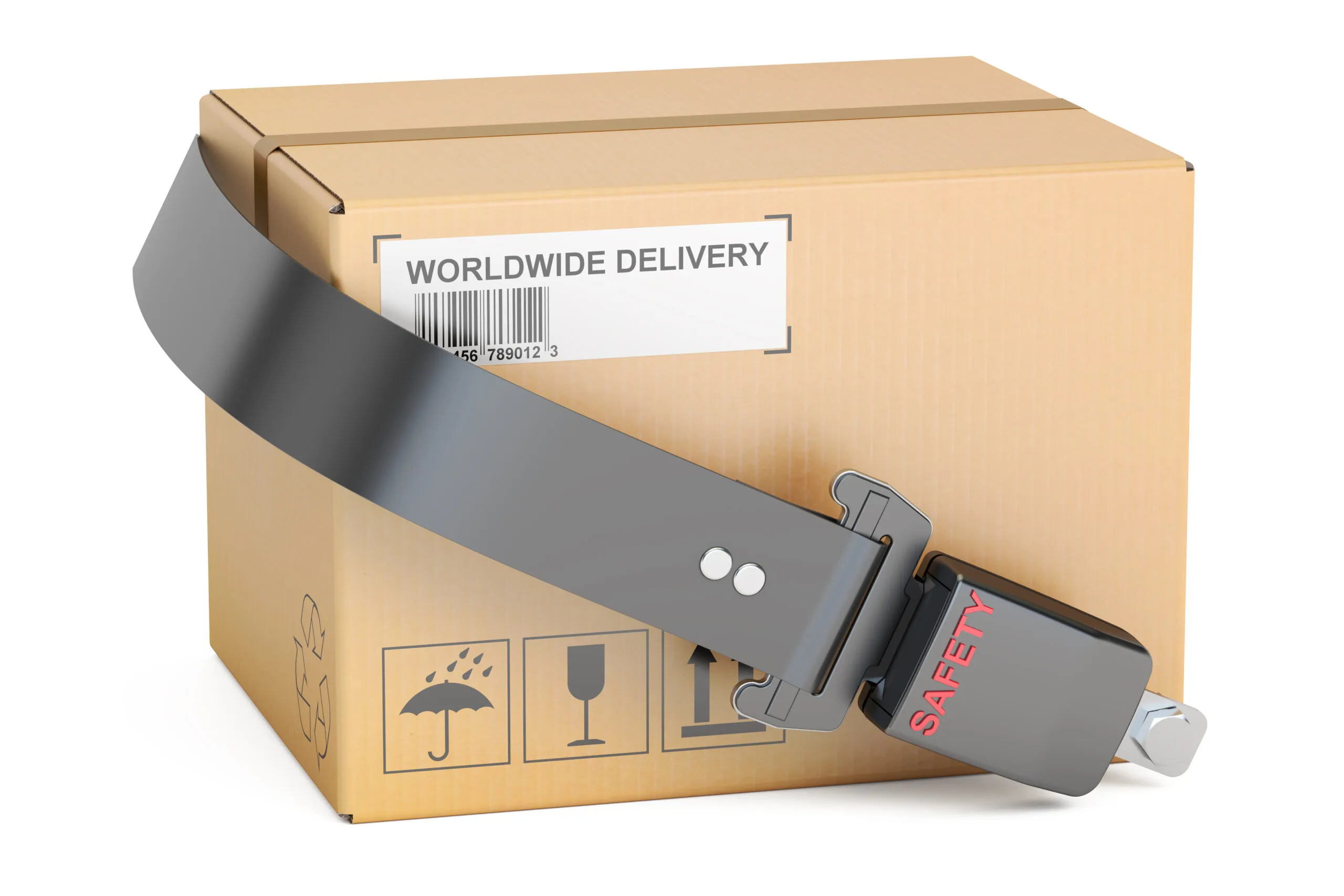
7 Tips for Shipping Taxidermy
Embark on a wild journey with our shipping taxidermy service! From majestic trophies to exotic specimens, we specialize in safely delivering your prized wildlife mounts to your doorstep. Explore our expert shipping solutions today and let your taxidermy adventure begin!

Shipping taxidermy involves the transportation of preserved animal specimens, such as mounted birds, mammals, or other wildlife, from one location to another. Taxidermy specimens are delicate and sensitive to handling, temperature, and humidity changes. Improper handling or exposure to extreme conditions can damage the specimens, leading to discoloration, warping, or deterioration. Taxidermy is a unique and valuable form of art that requires careful handling and consideration during the shipping process to preserve the specimens’ integrity and value.
We provide competitive freight shipping prices and an all-inclusive, easy-to-use shipping experience for our customers. Exceeding our customers’ expectations results in thousands of satisfied customer reviews and repeat business. We believe in the power of our customer relationships. Check out FreightCenter reviews from real customers, and learn what they have to say about their freight shipping experience!
- 2021, 2017 & 2016 Food Logistics’ Top Green Providers
- 2021 & 2018 Supply & Demand Chain Executives’ Pros to Know: Matthew Brosious
- 2020 & 2019 Top Food Logistics’ 3PL & Cold Storage Provider Award
- 2020 & 2019 Business Observer’s Top 500 Companies on the Gulf Coast
- 2020 & 2017 SmartWay® Transport Partner
- 2020 & 2017 Food Logistics’ Champions: Rock Stars of the Supply Chain
- 2020 Best of Palm Harbor Awards for Local Businesses
- 2017 Green Supply Chain Award from Supply & Demand Chain Executive
- 2017 Tampa Bay Business Journal Heroes at Work
- 2016, 2015, & 2012 Food Logistics Top 100 Software and Technology Providers
- 2013 Tampa Bay Business 100 by Tampa Bay Business Journal
- 2013 Top 100 Great Supply Chain Partners by SupplyChainBrain
- 2012 TIA Samaritan Award Honorable Mention
- 2012, 2011 & 2010 TBBJ Fast 50 Recipient
- 2013, 2011, & 2010 Diversity Business Top Businesses

Legal Considerations
Before shipping taxidermy, it is essential to understand the legal regulations related to the transportation of wildlife specimens. Shipping taxidermy that involves protected or endangered species may require specific permits and documentation. Check with local and international authorities to ensure compliance with wildlife conservation laws.
Choose the Right Shipping Carrier
Selecting the appropriate shipping carrier is crucial when shipping taxidermy. Look for a carrier experienced in handling delicate and valuable items. Some carriers specialize in shipping art and museum pieces, making them well-suited for transporting taxidermy.
Proper Packaging
Packaging taxidermy securely is vital to prevent damage during transit. Use a sturdy box or crate that provides ample space and cushioning. Wrap the taxidermy in acid-free tissue paper to protect its surface, and fill any gaps with bubble wrap or foam to avoid movement within the package.
Disassembly (if applicable)
For larger taxidermy pieces, such as life-size mounts or dioramas, disassembling may be necessary for safe transportation. Take detailed photographs during the disassembly process to aid in reassembly at the destination.
Labeling and Documentation
Properly label the package as “Fragile” and “Handle with Care.” Include clear shipping labels with the sender’s and recipient’s addresses. Additionally, attach a detailed packing list and documentation outlining the contents of the package and any required permits.
Temperature Considerations
Taxidermy specimens are sensitive to extreme temperatures. For delicate pieces or during extreme weather conditions, consider using temperature-controlled shipping options to preserve the specimen’s integrity.
Insurance
Consider investing in shipping insurance to protect the value of the taxidermy piece during transit. Insurance provides financial security for loss, damage, or theft.
Ethical Considerations
When shipping taxidermy, it is essential to uphold ethical standards. Ensure the taxidermy was obtained legally and ethically and complies with regulations concerning endangered species and protected wildlife.
Customs Clearance
If shipping taxidermy internationally, be aware of customs requirements and declarations in the destination country. Ensure all required paperwork and permits are completed accurately to facilitate smooth customs clearance.
#1 Legal Compliance
Taxidermy is a practice that requires careful attention to legal considerations, especially when shipping these delicate and valuable pieces. Various laws and regulations govern the transportation of taxidermy, aiming to protect wildlife and ensure ethical practices.
Endangered Species Act – ESA
The Endangered Species Act is a crucial law protecting species at risk of extinction. Some taxidermy specimens may belong to species listed as endangered or threatened under this act. Shipping or trading these specimens may require permits from the U.S. Fish and Wildlife Service or equivalent authorities in other countries. Compliance with the ESA is vital to prevent legal consequences and support wildlife conservation efforts.
Convention on International Trade in Endangered Species of Wild Fauna and Flora – CITES
CITES is an international agreement regulating the trade of wildlife and plants to prevent their exploitation and endangerment. Many taxidermy specimens, especially those from exotic animals, fall under CITES regulations. Shipping such specimens across international borders without the necessary permits can lead to severe penalties and confiscation.
State and Local Regulations
In addition to federal laws, various states, and local governments may have specific regulations governing taxidermy possession, transportation, and sale. These laws can vary significantly, so it is crucial to research and understand the requirements for the specific taxidermy piece and the locations involved in the shipping process.
Wildlife Import/Export Laws
Export and importing countries may have specific wildlife import and export laws when shipping taxidermy internationally. It is essential to comply with these regulations, which often involve obtaining permits and providing documentation to facilitate customs clearance.
Migratory Bird Treaty Act – MBTA
The MBTA is a federal law protecting migratory birds and their nests. Certain taxidermy specimens, such as birds covered by the MBTA, may require additional permits for shipping, especially when crossing international borders.
Protected Species
Apart from endangered species, some taxidermy specimens may belong to species protected under state or federal laws due to their ecological significance or rarity. It is essential to identify and verify the legal status of the taxidermy piece to ensure compliance with these protective measures.
Ethical Considerations
While not a legal requirement, ethical considerations play a significant role in the shipping of taxidermy. It is essential to ensure that the taxidermy was obtained legally and ethically, following responsible practices prioritizing wildlife conservation and sustainable hunting.
#2 Finding the Best Carrier to Ship Taxidermy
Selecting the best carrier is crucial to ensure your taxidermy pieces’ safe and secure transportation. With various shipping options available, it can take time to determine the most suitable carrier.
Experience and Specialization
Look for carriers with experience handling delicate and valuable items, such as art or museum pieces. Carriers with expertise in shipping taxidermy understand the specific requirements and precautions needed to transport these unique specimens safely.
Insurance Coverage
Insurance coverage is a critical aspect when choosing a carrier for shipping taxidermy. Ensure that the carrier provides comprehensive insurance that adequately covers the value of the taxidermy piece in case of loss, damage, or theft during transit.
Packaging and Handling
Review the carrier’s packaging and handling procedures. The carrier should have protocols to handle taxidermy carefully, including using appropriate packing materials to cushion and protect the specimen during transportation.
Temperature Control
Taxidermy specimens are sensitive to extreme temperatures. If shipping taxidermy in harsh weather conditions or to regions with significant temperature variations, consider carriers that offer temperature-controlled shipping options to preserve the integrity of the specimen.
Tracking and Monitoring
Real-time tracking and monitoring capabilities are essential when shipping taxidermy. Choose a carrier that provides a reliable tracking system, allowing the sender and recipient to monitor the shipment’s status throughout its journey.
Reputation and Reviews
Research the carrier’s reputation and read customer reviews to gauge their reliability and quality of service. Look for carriers with positive feedback from customers who have shipped similar delicate and valuable items.
Compliance with Regulations
Ensure the carrier complies with all relevant wildlife conservation and shipping regulations, especially when dealing with taxidermy specimens involving endangered or protected species. A reputable carrier will be knowledgeable about legal requirements and assist in obtaining any necessary permits for shipping.
Customization and Flexibility
Each taxidermy piece may have unique shipping requirements. Look for carriers that offer customizable shipping solutions and are willing to accommodate special requests to meet the specific needs of the transported taxidermy.
Shipping can incur substantial costs, especially for oversized or international shipments. Compare the shipping rates and service options of different carriers to find the most cost-effective solution without compromising safety and reliability.
FreightCenter can compare costs for you!
Customers can visit the FreightCenter website and input the details of their shipment, such as the pickup and delivery locations, dimensions and weight of the goods, and any special requirements. The quoting process is straightforward and can be completed within minutes.
FreightCenter has a vast network of reputable carriers, including LTL (Less-Than-Truckload) and FTL (Full Truckload) carriers, as well as specialized carriers for handling your cargo.
FreightCenter provides transparent pricing, meaning the quotes presented to customers include all the relevant costs associated with the shipment.
Once a shipment is booked through FreightCenter, customers can use their online tracking tools to monitor the status of their cargo throughout its journey.

#6 Insuring Taxidermy When Shipping: Protecting Valuable Specimens During Transit
Protecting Against Loss and Damage
Shipping taxidermy involves various risks, such as mishandling during transit, accidents, theft, or unforeseen events that can lead to loss or damage of the specimen. Insuring taxidermy provides financial protection against such risks, ensuring that the monetary value of the taxidermy is covered in case of unfortunate incidents.
Providing Peace of Mind
Knowing that taxidermy is insured offers peace of mind to both the sender and the recipient during the shipping process. This assurance allows individuals and businesses to ship taxidermy without excessive worry about potential financial losses, enabling them to focus on other important aspects of the shipment.
Financial Security for Taxidermy Sellers
For taxidermy sellers and businesses, insuring the taxidermy they ship provides financial security. In the event of loss or damage, insurance helps recover the value of the taxidermy, protecting the seller’s investment and business interests.
Ensuring Ethical Handling and Responsibility
Insuring taxidermy demonstrates ethical handling and responsibility on the part of the shipper. It shows a commitment to protecting these delicate specimens during transit and acknowledges the value of these works of art.
Customizable Coverage Options
Insurance for taxidermy can be tailored to meet the specific needs of the shipment. Depending on the value of the taxidermy and the level of risk involved, carriers offer customizable coverage options that suit individual requirements.
Expedited Claims Process
Reputable carriers offer an expedited claims process for insured shipments. In the rare event of loss or damage, the claims process is streamlined, allowing for prompt resolution and compensation.
Complying with Customer Requirements
Customers may often require taxidermy shipments to be insured for their protection. Taxidermy sellers can comply with customer requirements by insuring the shipment, fostering trust and confidence in their services.
#7 Customs Clearance When Shipping Taxidermy
Shipping taxidermy across international borders requires compliance with customs clearance procedures. Customs clearance is verifying and approving shipments by customs authorities to enter or exit a country.
When shipping taxidermy internationally, it is essential to understand and adhere to the legal requirements and documentation necessary for smooth customs clearance.
Understanding Customs Regulations
Customs regulations can vary significantly from one country to another. Researching and familiarizing yourself with the customs requirements of both the exporting and importing countries is crucial. This includes understanding any restrictions or prohibitions on the import or export of taxidermy and the necessary permits and documentation for customs clearance.
Compliance with CITES
The Convention on International Trade in Endangered Species of Wild Fauna and Flora (CITES) is an international agreement that regulates the trade of wildlife specimens. Many taxidermy specimens, especially those involving endangered or protected species, are covered by CITES regulations. Compliance with CITES permits and certificates is essential for customs clearance when shipping taxidermy internationally.
Wildlife Permits
In addition to CITES compliance, certain countries may require specific wildlife permits to import or export taxidermy. The relevant wildlife authorities issue these permits and serve to ensure that the taxidermy has been legally obtained and is not part of illegal wildlife trafficking.
Detailed Documentation
Proper and detailed documentation is essential for customs clearance. Prepare a complete packing list that outlines each taxidermy specimen, including its scientific name, country of origin, and any relevant identification marks. Include all required permits, licenses, and certificates as part of the documentation to support the shipment’s legality.
Accuracy and Transparency
When completing customs forms and declarations, accuracy and transparency are vital. Provide correct information about the shipment’s contents, value, and purpose. Avoid providing misleading or incorrect details, as this can lead to delays or issues with customs clearance.
Engage Professional Customs Broker
For complex international shipments or unfamiliar customs requirements, it may be beneficial to engage the services of a professional customs broker. A customs broker is experienced in handling customs procedures and can assist with preparing the necessary documentation and navigating the customs clearance process.
Plan for Potential Delays
Customs clearance can sometimes take time, especially if there are discrepancies or issues with the documentation. Plan for potential delays in the shipping timeline and communicate with the recipient about the estimated delivery time. FreightCenter can help get your packages ready for international shipments.
Shipping taxidermy requires attention to detail, adherence to legal regulations, and ethical considerations. By choosing the right shipping carrier, packaging securely, disassembling larger pieces if necessary, labeling correctly, providing documentation, considering temperature requirements, and insuring the shipment, you can ensure the safe transportation of taxidermy specimens. Respect for ethical practices, wildlife conservation laws, and customs regulations contributes to taxidermy’s responsible and ethical shipping, preserving these unique and valuable specimens for future generations to appreciate and study.
Why Choose FreightCenter?
An experienced third-party logistics company like FreightCenter can work with customers and business owners to ensure that the process of shipping taxidermy is shipped in a way that makes sense – safely and economically. FreightCenter is here to help you navigate the shipping process so that you can get your package to its destination on time.
Shipping Options
FreightCenter offers various shipping options, including less-than-truckload (LTL) and full-truckload (FTL) services. These options allow you to choose the most cost-effective and efficient method for transporting your taxidermy.
Carrier Network
FreightCenter has established relationships with a vast network of carriers. We can leverage these connections to find the best carriers for transporting taxidermy to your desired locations.
Pricing and Negotiation
FreightCenter has the expertise to negotiate favorable shipping rates due to the volume of shipments they handle. We can provide competitive pricing and ensure you get the best value for your shipping needs.
Freight Tracking
Tracking shipments is crucial in the shipping process. FreightCenter provides tracking services, enabling you to monitor the status and location of your taxidermy during transit.
Documentation and Compliance
Shipping taxidermy may involve various regulations and paperwork. FreightCenter can assist in handling the necessary documentation, ensure compliance with shipping regulations, and avoid potential delays or issues.
Insurance and Claims
FreightCenter offers cargo insurance options to protect your taxidermy against loss or damage during transit. If any issues arise, we can assist in filing claims and resolving disputes with the carrier.
Expert Assistance
FreightCenter has experienced logistics professionals who can provide guidance and support throughout the shipping process. We can help you plan the most efficient routes and address any potential challenges that may arise.
Shipping Taxidermy FAQs
Q. How do you ship taxidermy?
To ship taxidermy, freezing the animal and packing it in a box with crumpled newspaper or cellulose insulation on all sides is recommended. Consider lining the box with pink foam insulation or using a foam cooler with cellulose packing if it fits. This ensures secure and protective shipping of your taxidermy.
Q. What is the best way to transport taxidermy?
The best way to transport taxidermy is by using a rigid wooden crate. This will securely hold the mount in place and prevent any movement during transit. Additionally, ensure that any extra space in the crate is filled with proper packing materials for added protection.
Q. How do you ship a deer head?
When shipping a deer head, ensure the crate has 1 inch of Styrofoam on each side. To prevent movement, use packing peanuts to secure the antlers. Another option is to hire a small load mover for delivery inside a home or business. Proper packing and professional assistance are key for safe shipping of a deer head.
Q. How do you ship a trophy?
To ship a trophy, opt for a sufficiently spacious box with extra space all around. Place a layer of styrofoam peanuts at the bottom, followed by packing paper as a cushion. Wrap the trophy in large bubble wrap, ensuring to cover the entire length and tuck it securely.
Q. Is insurance necessary for shipping?
Yes, insurance is necessary for shipping if you want added protection for your shipments. You can purchase additional coverage from different couriers to safeguard items above their declared value. Sellers should ensure that shipments valued over $100 USD are declared properly to avail of insurance options. Protect your shipments and ensure a worry-free shipping experience.
Q. What does shipping insurance do?
Shipping insurance covers lost, stolen, or damaged packages. To claim the insurance, file a claim based on the declared value of your items. The carrier will validate the loss during the claims process, and you’ll be reimbursed accordingly. This insurance offers protection and peace of mind for unexpected circumstances with your shipments.
Q. Can you ship taxidermy to US?
Yes, it is possible to ship taxidermy to the United States without a USDA veterinary import permit. However, port inspectors may inspect the trophies upon arrival to ensure their condition. These fully taxidermy finished trophies serve as personal souvenirs for hunters and require no additional permits for importation.







